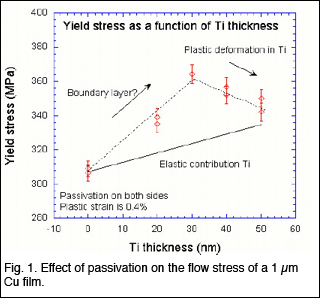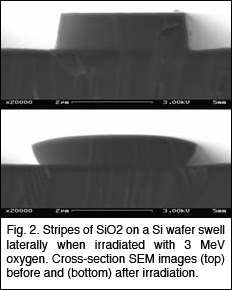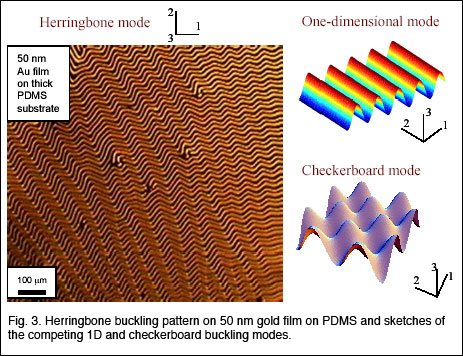




| IRG I – MULTISCALE MECHANICS of FILMS and INTERFACES | |
| Coordinator: Frans Spaepen | |
| Michael J. Aziz (DEAS) Michael P. Brenner (DEAS) Jene A. Golovchenko (Physics, DEAS) John W. Hutchinson (DEAS) Efthimios Kaxiras (Physics, DEAS) James R. Rice (DEAS, EPS) |
Frans Spaepen (DEAS) |
| Collaborators: Gareth H. McKinley
(MIT) Number of graduate students: 3 Number of postdoctoral associates: 2 |
|
This IRG investigate the behavior of thin film. Many different classes of films are investigated within the interdisciplinary effort. These include colloidal films, which are important in their own right as coating materials and which can be used as model systems for the study of the structures that can form at the interfaces. These also include films of more traditional materials, whose properties are being investigated. This work will continue as the participants begin to unravel the details of the behavior observed, and apply this to the development of improved descriptions of the physics. Drying is a crucial step in the processing of many forms of thin films, from a common coat of paint to emerging photonic band-gap structures. As the suspending fluid evaporates, fracture, delamination, and buckling can occur, ruining the quality of the thin film. Weitz, Hutchinson and Xie, working with a series of REU students, explored drying of nanoparticle suspensions, which are particularly prone to fracture. In the nanoparticle regime, drying stresses, originating from the affinity of the fluid for suspended particles, can exceed 1000 times atmospheric pressure. These enormous stresses can create beautiful patterns of cracks in drying films. The dynamics of crack growth sheds light on the subtle interplay of the elasticity of the jammed particle network with the viscous fluid permeating the pore space. Since these gaps are only a few molecules across, fluid molecules can be arrested by strong short-ranged interactions with the nanoparticles. Recently several MRSEC REU students have demonstrated the importance of these molecular-scale interactions on the macroscopic dynamics of drying nanoparticle suspensions, and have determined the means by which the cracks form as the film dries. These studies will be extended to investigate the buckling of shells of particles formed when particle-laden droplets dry. In another project, Vlassak is collaborating with Spaepen and Hutchinson to develop an understanding of the effect of various microstructural parameters on the mechanical behavior of thin metal films. They have developed an experimental technique to evaluate the stress-strain behavior of thin metal films using simple silicon micromachining techniques. This past year they used this technique for a focused study of the mechanical behavior of electroplated Cu thin films with controlled microstructures. The effect of film thickness was studied
by preparing Cu films with varying thickness but constant microstructure
using chemical mechanical polishing (CMP). Both unpassivated films
and films passivated with 20–50 nm of Ti were investigated.
The constant microstructure was confirmed by measuring the orientation
distribution functions (ODF) of the films by means of XRD and by
measuring the grain size through use of orientation imaging microscopy
(OIM). Discrete dislocation modeling for films on substrates suggests
that when deforming a film on a substrate, a boundary layer with
increased dislocation density forms at the interface with the substrate.
As a result of this boundary layer, the flow stress of the film
increases with decreasing film thickness. To verify formation of
this type of boundary layers, stress-strain curves of both passivated
and unpassivated freestanding films were measured. The passivation
layer has indeed a significant effect on the work hardening rate
of the films. Figure 1 Aziz and Golovchenko have
used 3 MeV oxygen irradiation of SiO2 strips to induce large deformations
(Fig. 2). A constitutive relation for this behavior
has been proposed by Hutchinson. With a better
understanding of the ways in which ions produce defects, create
and relieve stress,
and induce mass transport, ion beams might be the basis of morphology
control for the next generation of solid-state electronic and MEMS
devices. MeV ion beams are being used to generate and relieve stresses
in “hard” solids in experiments on morphology evolution
and control. Aziz and Golovchenko are
now using the measured morphology changes for a quantitative test
of theories for morphology evolution. They have also found that
this ion-induced deformation effect can be used to manipulate small
gaps between amorphous metal electrodes, and they have shown that
precise dimensional control is possible using feedback such as
electron tunneling. In another project, thin films formed from colloidal suspensions are used to study a variety of phenomena common to thin films of more traditional hard materials. The colloidal particles self-organize into crystalline structures similar to atoms in different phases of condensed matter. Being several orders of magnitude larger than atoms, the colloidal particles offer the unique possibility for studies at convenient length and time scales. Spaepen and Weitz are performing deformation experiments on thin films of colloidal particles in the crystalline and amorphous state to gain deeper insight into atomic processes of plastic deformation. They prepare large fcc colloidal crystals by slow sedimentation of the colloidal particles onto a patterned template consisting of holes of particle size in a coating of PMMA. They find dislocation defects in close analogy to those in atomic systems. The dislocations that observed are known as Shockley partial dislocations, the most prominent type of a dislocation in fcc metals. They constructed a laser microscope by analogy to a transmission electron microscope: They apply a two-beam method, in which the strain field of the dislocation is imaged as a diffraction contrast. The laser microscope enables them to observe dislocation dynamics during mechanical testing as well as during crystal growth. They have studied the formation, motion and interactions of dislocations during indentation tests as well as during crystal growth on slightly stretched templates. This is the first use of a laser microscope to image dislocations in colloidal crystals, and the first attempt to investigate the dislocations in these crystals. This work will be extended by combining the imaging using the laser microscope with that obtained using a confocal microscope, which can image every particle individually, allowing the defect structure to be precisely determined. In addition, indentation experiments will be performed to investigate the nucleation and growth of the defects as the structures are indented. |
|

Last Modified April 27, 2004.
 shows the flow stress at
0.4% plastic strain as a function of the thickness of the passivating
layer.
The passivation clearly results in a strengthening of the Cu films
with a maximum effect when the passivating layers are approximately
30 nm thick. This result is consistent with formation of a boundary
layer. TEM observation of deformed films with passivating layers
indeed show a 50–100 nm layer of increased dislocation density
near the Cu/Ti interfaces. The decrease in strengthening for passivating
layers in excess of 30 nm can be attributed to plastic deformation
in the Ti and the resulting decrease in constraint.
shows the flow stress at
0.4% plastic strain as a function of the thickness of the passivating
layer.
The passivation clearly results in a strengthening of the Cu films
with a maximum effect when the passivating layers are approximately
30 nm thick. This result is consistent with formation of a boundary
layer. TEM observation of deformed films with passivating layers
indeed show a 50–100 nm layer of increased dislocation density
near the Cu/Ti interfaces. The decrease in strengthening for passivating
layers in excess of 30 nm can be attributed to plastic deformation
in the Ti and the resulting decrease in constraint. 
 Hutchinson studied
the buckling of a thin metal film vapor deposited on thick elastomer
substrate.
It develops an equi-biaxial compressive stress state when the system
is cooled due to the large thermal expansion mismatch between the
elastomer and the metal. At a critical stress, the film undergoes
buckling into a family of modes with short wavelengths characteristic
of a thin plate on a compliant elastic foundation. As the system
is further cooled, a highly ordered herringbone pattern has been
observed to develop (Fig. 3). A MRSEC study by Hutchinson has
shown that the herringbone mode constitutes a minimum energy configuration.
A one-dimensional mode (Fig. 3) relaxes compressive
stress perpendicular to the undulations but provides no relief
to the stress in the
film parallel to the undulations. A square checker-board mode provides
relief in all directions, but not nearly as much as the herringbone.
The secret to the herringbone mode is that, apart from local regions
in the vicinity of the “jogs,” the Gaussian curvature
of the film is zero such that there is very little energy penalty
due to stretch.
Hutchinson studied
the buckling of a thin metal film vapor deposited on thick elastomer
substrate.
It develops an equi-biaxial compressive stress state when the system
is cooled due to the large thermal expansion mismatch between the
elastomer and the metal. At a critical stress, the film undergoes
buckling into a family of modes with short wavelengths characteristic
of a thin plate on a compliant elastic foundation. As the system
is further cooled, a highly ordered herringbone pattern has been
observed to develop (Fig. 3). A MRSEC study by Hutchinson has
shown that the herringbone mode constitutes a minimum energy configuration.
A one-dimensional mode (Fig. 3) relaxes compressive
stress perpendicular to the undulations but provides no relief
to the stress in the
film parallel to the undulations. A square checker-board mode provides
relief in all directions, but not nearly as much as the herringbone.
The secret to the herringbone mode is that, apart from local regions
in the vicinity of the “jogs,” the Gaussian curvature
of the film is zero such that there is very little energy penalty
due to stretch.